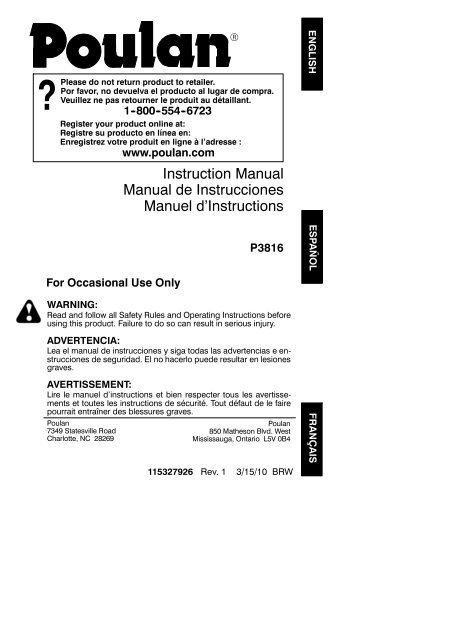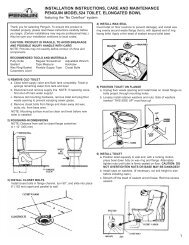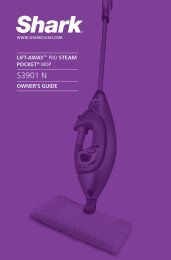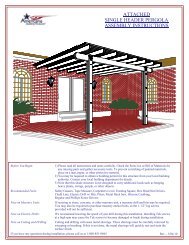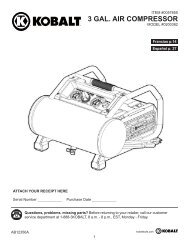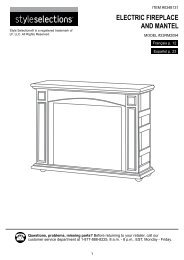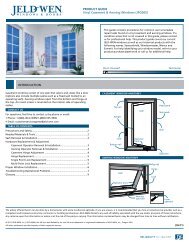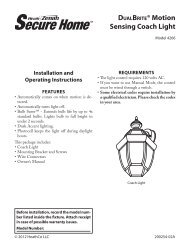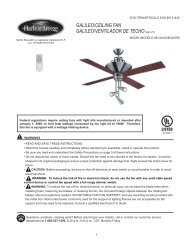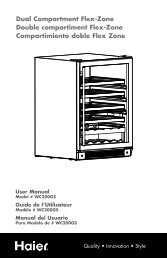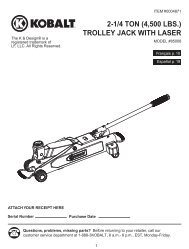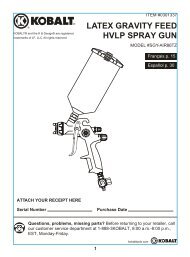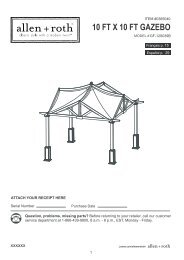OM, P3816, 2010-03, CHAIN SAWS, 966557801 - Poulan
OM, P3816, 2010-03, CHAIN SAWS, 966557801 - Poulan
OM, P3816, 2010-03, CHAIN SAWS, 966557801 - Poulan
Create successful ePaper yourself
Turn your PDF publications into a flip-book with our unique Google optimized e-Paper software.
Please do not return product to retailer.Por favor, no devuelva el producto al lugar de compra.Veuillez ne pas retourner le produit au détaillant.<strong>Poulan</strong>7349 Statesville RoadCharlotte, NC 282691 -800 -554 -6723RRegister your product online at:Registre su producto en línea en:Enregistrez votre produit en ligne à l’adresse :www.poulan.comFor Occasional Use OnlyInstruction ManualManual de InstruccionesManuel d’Instructions<strong>P3816</strong>WARNING:Read and follow all Safety Rules and Operating Instructions beforeusing this product. Failure to do so can result in serious injury.ADVERTENCIA:Lea el manual de instrucciones y siga todas las advertencias e enstruccionesde seguridad. El no hacerlo puede resultar en lesionesgraves.AVERTISSEMENT:Lire le manuel d’instructions et bien respecter tous les avertissementset toutes les instructions de sécurité. Tout défaut de le fairepourrait entraîner des blessures graves.<strong>Poulan</strong>850 Matheson Blvd. WestMississauga, Ontario L5V 0B4115327926 Rev. 1 3/15/10 BRWENGLISH ESPAÑOL FRANÇAIS
IDENTIFICATION OF SYMBOLSWARNING! This chainsaw can be dangerous! Carelessor improper use can causeserious or even fatal injury.Read and understand theinstruction manual beforeusing the chain saw.Always wear appropriate ear protection, eye protection and head protection.Always use two hands when operating the chain saw.WARNING! Contacting the guide bar tip with any objectshould be avoided; tip contact may cause the guide bar tomove suddenly upward and backward, which may cause seriousinjury.XX_Measured maximum kickback value without chain brake for the barand chain combination on the label.Starting ReminderMove ON/STOP switch tothe ON position.Pull the starter ropesharply 5 times with yourright hand.Slowly press primer bulb6times.Push the choke/fast idlelever in to the HALFCHOKE position.Pull choke/fast idle leverout to the full extent (tothe FULL CHOKE position).Pull the starter rope sharplywith your right hand untilthe engine starts.SAFETY RULESWARNING: Always disconnectspark plug wire and place wire where it cannotcontact spark plug to prevent accidentalstarting when setting up, transporting, adjustingor making repairs except carburetoradjustments.Because a chain saw is a high-speed woodcuttingtool, special safety precautions mustbe observed to reduce the risk of accidents.Careless or improper use of this tool cancause serious injury.2PLAN AHEADS Read this manual carefully until you completelyunderstand and can follow all safetyrules, precautions, and operating instructionsbefore attempting to use the unit.S Restrict the use of your saw to adult userswho understand and can follow safetyrules, precautions, and operating instructionsfound in this manual.S Wear protective gear. Always use steeltoedsafety footwear with non-slip soles;snug-fitting clothing; safety chaps; heavy-
duty, non-slip gloves; eye protection suchas non-fogging, vented goggles or facescreen; an approved safety hard hat; andsound barriers (ear plugs or mufflers) toprotect your hearing. Regular usersshould have hearing checked regularly aschain saw noise can damage hearing. Securehair above shoulder length.HearingProtectionSnug FittingClothingSafety ShoesSafety HatEyeProtectionHeavy DutyGlovesSafety ChapsS Keep all parts of your body away from thechain when the engine is running.S Keep children, bystanders, and animals aminimum of 30 feet (10 meters) away fromthe work area. Do not allow other peopleor animals to be near the chain saw whenstarting or operating the chain saw.S Do not handle or operate a chain saw whenyou are fatigued, ill, or upset, or if you havetaken alcohol, drugs, or medication. Youmust be in good physical condition and mentallyalert. Chain saw work is strenuous. Ifyou have any condition that might be aggravatedby strenuous work, check with yourdoctor before operating a chain saw.S Carefully plan your sawing operation in advance.Do not start cutting until you have aclear work area, secure footing, and, if youare felling trees, a planned retreat path.OPERATE YOUR SAW SAFELYS Do not operate a chain saw with one hand.Serious injury to the operator, helpers, bystandersor any combination of these personsmay result from one-handed operation.A chain saw is intended fortwo-handed use.S Operate the chain saw only in a well-ventilatedoutdoor area.S Do not operate saw from a ladder or in atree.S Make sure the chain will not make contactwith any object while starting the engine.Never try to start the saw when the guidebar is in a cut.S Do not put pressure on the saw at the end ofthe cut. Applying pressure can cause you tolose control when the cut is completed.S Stop the engine before setting the sawdown.S Do not operate a chain saw that is damaged,improperly adjusted, or not completelyand securely assembled. Alwaysreplace bar, chain, hand guard, or chainbrake immediately if it becomes damaged,broken or is otherwise removed.3S With the engine stopped, hand carry thechain saw with the muffler away from yourbody, and the guide bar and chain to therear, preferably covered with a scabbard.MAINTAIN YOUR SAW IN GOODWORKING ORDERS Have all chain saw service performed by aqualified service dealer with the exceptionof the items listed in the maintenance sectionof this manual. For example, if impropertools are used to remove or hold the flywheelwhen servicing the clutch, structuraldamage to the flywheel can occur andcause the flywheel to burst.S Make certain the saw chain stops movingwhen the throttle trigger is released. Forcorrection, refer to CARBURETOR AD-JUSTMENT.S Never modify your saw in any way.S Keep the handles dry, clean, and free of oilor fuel mixture.S Keep fuel and oil caps, screws, and fastenerssecurely tightened.S Use only <strong>Poulan</strong> accessories and replacementparts as recommended.HANDLE FUEL WITH CAUTIONS Do not smoke while handling fuel or whileoperating the saw.S Eliminate all sources of sparks or flame inthe areas where fuel is mixed or poured.There should be no smoking, open flames,or work that could cause sparks. Allow engineto cool before refueling.S Always have fire extinguishing tools availableif you should need them.S Mix and pour fuel in an outdoor area onbare ground; store fuel in a cool, dry, wellventilated place; and use an approved,marked container for all fuel purposes.Wipe up all fuel spills before starting saw.S Move at least 10 feet (3 meters) from fuelingsite before starting engine.S Turn the engine off and let saw cool in anon-combustible area, not on dry leaves,straw, paper, etc. Slowly remove fuel capand refuel unit.S Store the unit and fuel in an area where fuelvapors cannot reach sparks or openflames from water heaters, electric motorsor switches, furnaces, etc.KICKBACKWARNING: Avoid kickback whichcan result in serious injury. Kickback is thebackward, upward or sudden forward motionof the guide bar occurring when the saw chainnear the upper tip of the guide bar contacts anyobject such as a log or branch, or when thewood closes in and pinches the saw chain inthe cut. Contacting a foreign object in the woodcan also result in loss of chain saw control.S Rotational Kickback can occur when themoving chain contacts an object at the uppertip of the guide bar. This contact cancause the chain to dig into the object,which stops the chain for an instant. Theresult is a lightning fast, reverse reactionwhich kicks the guide bar up and back towardthe operator.
S Pinch-Kickback can occur when the thewood closes in and pinches the movingsaw chain in the cut along the top of theguide bar and the saw chain is suddenlystopped. This sudden stopping of thechain results in a reversal of the chainforce used to cut wood and causes thesaw to move in the opposite direction of thechain rotation. The saw is driven straightback toward the operator.S Pull-In can occur when the moving chaincontacts a foreign object in the wood in thecut along the bottom of the guide bar and thesaw chain is suddenly stopped. This suddenstopping pulls the saw forward and awayfrom the operator and could easily cause theoperator to lose control of the saw.Avoid Pinch -Kickback:S Be extremely aware of situations or obstructionsthat can cause material to pinchthe top of or otherwise stop the chain.S Do not cut more than one log at a time.S Do not twist the saw as the bar is withdrawnfrom an undercut when bucking.Avoid Pull -In:S Always begin cutting with the engine at fullspeed and the saw housing against wood.S Use wedges made of plastic or wood.Never use metal to hold the cut open.S Begin and continue cutting at full speed. Ifthe chain is moving at a slower speed,there is greater chance of kickback occurring.S Cut one log at a time.S Use extreme caution when re-entering aprevious cut.S Do not attempt cuts starting with the tip ofthe bar (plunge cuts).S Watch for shifting logs or other forces thatcould close a cut and pinch or fall intochain.S Use the Reduced -Kickback Guide Barand Low -Kickback Chain specified foryour saw.MAINTAIN CONTROLStand to theleft of the sawNever reversehand positionsThumb onunderside ofhandlebarKickback PathAvoid ObstructionsElbow lockedThumb on underside ofhandlebarClear The Working AreaREDUCE THE CHANCE OFKICKBACKS Recognize that kickback can happen.With a basic understanding of kickback,you can reduce the element of surprisewhich contributes to accidents.S Never let the moving chain contact any objectat the tip of the guide bar.S Keep the working area free from obstructionssuch as other trees, branches, rocks,fences, stumps, etc. Eliminate or avoidany obstruction that your saw chain couldhit while you are cutting. When cutting abranch, do not let the guide bar contactbranch or other objects around it.S Keep your saw chain sharp and properlytensioned. A loose or dull chain can increasethe chance of kickback occurring.Follow manufacturer’s chain sharpeningand maintenance instructions. Check tensionat regular intervals with the enginestopped, never with the engine running.Make sure the bar nuts are securely tightenedafter tensioning the chain.4S Keep a good, firm grip on the saw with bothhands when the engine is running anddon’t let go. A firm grip will help you reducekickback and maintain control of the saw.Keep the fingers of your left hand encirclingand your left thumb under the fronthandlebar. Keep your right hand completelyaround the rear handle whetheryour are right handed or left handed. Keepyour left arm straight with the elbowlocked.S Position your left hand on the front handlebarso it is in a straight line with your righthand on the rear handle when makingbucking cuts. Never reverse right and lefthand positions for any type of cutting.S Stand with your weight evenly balanced onboth feet.S Stand slightly to the left side of the saw tokeep your body from being in a direct linewith the cutting chain.S Do not overreach. You could be drawn orthrown off balance and lose control of thesaw.S Do not cut above shoulder height. It is difficultto maintain control of saw aboveshoulder height.
KICKBACK SAFETY FEATURESWARNING: The following featuresare included on your saw to help reduce thehazard of kickback; however, such featureswill not totally eliminate this danger. As achain saw user, do not rely only on safety devices.You must follow all safety precautions,instructions, and maintenance in thismanual to help avoid kickback and otherforces which can result in serious injury.S Reduced -Kickback Guide Bar, designedwith a small radius tip which reduces thesize of the kickback danger zone on thebar tip. A Reduced -Kickback Guide Barhas been demonstrated to significantly reducethe number and seriousness of kickbackswhen tested in accordance withsafety requirements for gasoline poweredchain saws as set by ANSI B175.1.Reduced Kickback Symmetrical Guide BarSymmetrical Guide BarSmall Radius TipLarge Radius TipS Low -Kickback Chain, designed with acontoured depth gauge and guard linkwhich deflect kickback force and allowwood to gradually ride into the cutter. Low -Kickback Chain has met kickback performancerequirements when tested on arepresentative sample of chain saws below3.8 cubic inch displacement specifiedin ANSI B175.1.Contoured Depth GaugeElongated Guard LinkLow --- KickbackChainNot a Low--- Kickback ChainDeflectskickback forceand allows woodto gradually rideinto cutterCan Obstruct MaterialS Front Hand Guard, designed to reduce thechance of your left hand contacting the chainif your hand slips off the front handlebar.S Position of front and rear handlebars, designedwith distance between handles and“in-line” with each other. The spread and“in-line” position of the hands provided bythis design work together to give balanceand resistance in controlling the pivot ofthe saw back toward the operator if kickbackoccurs.<strong>CHAIN</strong> BRAKE AND CKA ANGLES Chain Brake, designed to stop the chain inthe event of kickback.WARNING: WE DO NOT REP-RESENT AND YOU SHOULD NOT AS-SUME THAT THE <strong>CHAIN</strong> BRAKE WILLPROTECT YOU IN THE EVENT OF A KICK-BACK. Kickback is a lightning fast actionwhich throws the bar and rotating chain backand up toward the operator. Kickback can becaused by allowing contact of the bar tip in thedanger zone with any hard object. Kickbackcanalsobecausedbypinchingthesawchainalong the top of the guide bar. This action maypush the guide bar rapidly back toward the operator.Either of these events may cause youto lose control of the saw which could result inserious injury or even death. DO NOT RELYUPON ANY OF THE DEVICES BUILT INTOYOUR SAW. YOU SHOULD USE THE SAWPROPERLY AND CAREFULLY TO AVOIDKICKBACK. Reduced-kickback guide barsand low -kickback saw chains reduce thechance and magnitude of kickback and arerecommended. Your saw has a low kickbackchain and bar as original equipment. Repairson a chain brake should be made by an authorizedservicing dealer. Take your unit to theplace of purchase if purchased from a servicingdealer, or to the nearest authorized masterservice dealer.S Tip contact in some cases may cause a lightningfast reverse REACTION, kicking guidebar up and back toward operator.S Pinching the saw chain along the top of theguide bar may push the guide bar rapidlyback toward the operator.S Either of these reactions may cause you tolose control of the saw which could result inserious injury. Do not rely exclusively upondevices built into your saw.5WARNING: Computed kickbackangle (CKA) listed on your saw and listed in theCKA table below represents angle of kickbackyour bar and chain combinations will havewhen tested in accordance with CSA (CanadianStandards Association) and ANSI standards.When purchasing replacement bar andchain, considerations should be given to thelower CKA values. Lower CKA values representsafer angles to the user, higher values indicatemore angle and higher kick energies.Computed angles represented indicate totalenergy and angle associated without activationof the chain brake during kickback. Activatedangle represents chain stopping time relative toactivation angle of chain break and resultingkick angle of saw. In all cases lower CKA valuesrepresent a safer operating environmentfor the user.The following guide bar and chain combinationsmeet kickback requirements of CSAStandards Z62.1, Z62.3, & ANSI B175.1when used on saws listed in this manual.Use of bar and chain combinations otherthan those listed is not recommended andmay not meet the CKA requirements perstandard.
Computed kickback angle (CKA) TableBARMODEL P/N Length <strong>CHAIN</strong> P/N CKA without chain brake<strong>P3816</strong> 530044748 16″ 95205121133_NOTE: Ifthissawistobeusedforcommerciallogging, a chain brake is requiredand shall not be removed or otherwise disabledto comply with Federal OSHA Regulationsfor Commercial Logging.WARNING: The engine exhaustfrom this product contains chemicals knownto the State of California to cause cancer,birth defects or other reproductive harm.SAFETY NOTICE: Exposure to vibrationsthrough prolonged use of gasoline poweredhand tools could cause blood vessel or nervedamage in the fingers, hands, and joints ofpeople prone to circulation disorders orabnormal swellings. Prolonged use in coldweather has been linked to blood vesseldamage in otherwise healthy people. Ifsymptoms occur such as numbness, pain,loss of strength, change in skin color or texture,or loss of feeling in the fingers, hands, or joints,discontinue the use of this tool and seekmedical attention. An anti-vibration systemdoes not guarantee the avoidance of theseproblems. Users who operate power tools ona continual and regular basis must monitorclosely their physical condition and thecondition of this tool.Protective gloves (not provided) should beworn during assembly.ATTACHING THE BAR & <strong>CHAIN</strong> (If notalready attached)ASSEMBLYSPECIAL NOTICE: Your saw is equippedwith a temperature limiting muffler and sparkarresting screen which meets therequirements of California Codes 4442 and4443. All U.S. forest land and the states ofCalifornia, Idaho, Maine, Minnesota, NewJersey, Oregon, and Washington require bylaw that many internal combustion enginesto be equipped with a spark arresting screen.If you operate a chain saw in a state or localewhere such regulations exist, you are legallyresponsible for maintaining the operatingcondition of these parts. Failure to do so isa violation of the law. Refer to the SERVICEsection for maintenance of the sparkarresting screen.Failure to follow all Safety Rules and Precautionscan result in serious injury. If situationsoccur which are not covered in this manual,use care and good judgement. If you needassistance, contact your authorized servicedealer or call 1-800 -554 -6723.STANDARDS: This saw is listed by Underwriter’sLaboratories, Inc., in accordance with:ANSI B175.1 -2000 American NationalStandards for Gasoline -Powered ChainSaws - Safety RequirementsCSA Z62.1 -<strong>03</strong> Chain Saws - OccupationalHealth and SafetyCSA Z62.3 -96 Chain Saw Kickback OccupationalHealth and SafetyWARNING: If received assembled,repeat all steps to ensure your saw is properlyassembled and all fasteners are secure. Alwayswear gloves when handling the chain.The chain is sharp and can cut you even whenit is not moving!1. Loosen and remove the bar nuts and theclutch cover from the saw.2. Remove the plastic shipping spacer (ifpresent).Clutch coverBar nutsChain adjustment tool(Bar Tool)Location ofshippingspacer3. Turn adjusting screw on bar counterclockwiseto move the tensioning rack as far asit will go toward the front of the bar.6
Tensioning RackAdjustingScrew4. Slide guide bar on bar bolts until guidebar stops against clutch drum sprocket.NOTE: When adjusting chain tension,make sure the bar nuts are finger tight only.Attempting to tension the chain when the barnuts are tight can cause damage.Checking the tension:Use the screwdriver end of the chain adjustmenttool (bar tool) to move chain aroundguide bar. If the chain does not rotate, it is tootight. If the chain is too loose, it will sag belowthe bar.GuideBarBar boltsGuide bar5. Carefully remove the chain from the package.Hold chain with the drive links asshown.Tip ofBarBar NutsAdjustingScrewAdjusting the tension:Chain AdjustmentTool(Bar Tool)Chain tension is very important. Chainsstretch during use. This is especially trueduring the first few times you use your saw.Always check chain tension each time beforeyou start the chain saw.An adjusting screw (located on the guidebar) is used to adjust the tension of the chain(see illustration).1. Loosen bar nuts until they are finger tightagainst the clutch cover.2. Turn adjusting screw clockwise until chainsolidly contacts bottom of guide bar rail.CUTTERS MUST FACE INDIIRECTION OF ROTATIONCuttersDepth GaugeAdjustingScrewDrive Links6. Place chain over and behind clutch retainer,fitting the drive links in the clutchdrum sprocket.7. Fit bottom of drive links between theteeth in the sprocket in the nose of theguide bar.8. Fit chain drive links into bar groove.9. Pull guide bar forward until chain is snugin guide bar groove. Ensure all drivelinks are in the bar groove.10. Hold guide bar against the saw frameand install the clutch cover.11. Replace the bar nuts and tighten fingertight. Once the chain is tensioned youwill need to tighten bar nuts.<strong>CHAIN</strong> TENSION(Including units with chain already installed)WARNING: Wear protective gloveswhen handling chain. The chain is sharp andcan cut you even when it is not moving.73. Using bar tool, roll chain around guide barto ensure all links are in bar groove.4. Lift up tip of guide bar to check for sag.Release tip of guide bar, then turn adjustingscrew until sag does not exist.5. While lifting tip of guide bar, tighten barnuts securely with the bar tool.Bar Nuts6. Use the screwdriver end of the bar toolto move chain around guide bar.7. If chain does not rotate, it is too tight.Slightly loosen bar nuts and loosenchain by turning the adjusting screw.Retighten bar nuts.
8. If chain is too loose, it will sag below theguide bar. DO NOT operate the saw ifthe chain is loose.NOTE: The chain is tensioned correctlywhen the weight of the chain does not cause itto sag below the guide bar (with the chain sawsitting in an upright position), but the chain stillmoves freely around the guide bar.OPERATIONWARNING: If the saw is operatedwith a loose chain, the chain could jump off theguide bar and result in serious injury to the operatorand/or damage the chain making it unusable.If the chain jumps off the guide bar, inspecteach drive link for damage. Damagedchain must be repaired or replaced.KNOW YOUR <strong>CHAIN</strong> SAWREAD THIS INSTRUCTION MANUAL AND SAFETY RULES BEFORE OPERATING YOUR<strong>CHAIN</strong> SAW. Compare the illustrations with your unit to familiarize yourself with the location ofthe various controls and adjustments. Save this manual for future reference.Chain Front Hand GuardFront HandleAdjustment Tool(Bar Tool)Starter RopeON/STOPSwitch Choke/Fast IdleChain MufflerLeverBarSprocketHoleBar Oil Fill CapStarter HousingFuel Mix Fill CapPrimer BulbCylinder CoverThrottleLockoutRearHandleChainBrakeAdjusting ScrewChainDirectionof TravelThrottleTriggerClutch CoverBar NutsON/STOP SWITCHThe ON/STOP SWITCH is used to stop theengine.THROTTLE TRIGGERThe THROTTLE TRIGGER controls enginespeed.THROTTLE LOCK -OUTThe THROTTLE LOCK -OUT must bepressed before you can squeeze the throttletrigger. This feature prevents you from accidentallysqueezing the trigger.CHOKE/FAST IDLE LEVERThe choke and fast idle are set by pulling theCHOKE/FAST IDLE LEVER out to the full extentfor cold starting or after refueling. Thechoke provides additional fuel to the engineduring cold starting.8ChainCatcherGuide BarPRIMER BULBThe PRIMER BULB circulates fuel to the carburetorto provide quicker starting.<strong>CHAIN</strong> BRAKEThe chain brake is a device designed to stopthe chain if kickback occurs. The chain brakeactivates automatically in the event of kickback.The chain brake activates manually if thefront hand guard is pushed forward. The chainbrake is disengaged by pulling the front handguard back toward the front handle as far aspossible.<strong>CHAIN</strong> TENSIONIt is normal for a new chain to stretch during thefirst 15 minutes of operation. You should checkyour chain tension each time before you startthe chain saw. See <strong>CHAIN</strong> TENSION underthe ASSEMBLY section.
WARNING: If the saw is operatedwith a loose chain, the chain could jump offthe guide bar and result in serious injury tothe operator and/or damage the chain makingit unusable.BEFORE STARTING ENGINEWARNING: Muffler is very hot duringand after use. Do not touch the muffler or allowcombustible material such as dry grassor fuel to do so.WARNING: Be sure to read the fuelhandling information in the safety rules sectionof this manual before you begin. If you donot understand the fuel handling informationdo not attempt to fuel your unit. Seek helpfrom someone that does understand the informationor call the customer assistancehelp line at 1-800-554-6723.FUELING ENGINEWARNING: Remove fuel cap slowlywhen refueling.HELPFUL TIPTo obtain the correct oil mixratio, pour 3.2 ounces of2-cycle synthetic oil intoone gallon of fresh gas.This engine is certified to operate on unleadedgasoline. Before operation, gasoline must bemixed with a good quality synthetic 2-cycle aircooledengine oil designed to be mixed at a ratioof 40:1. <strong>Poulan</strong>/WEED EATER brand syntheticoil is recommended. A 40:1 ratio isobtained by mixing 3.2 fluid ounces (95 ml) ofoil with 1 gallon (4 liters) of unleaded gasoline.Included with this saw is a 3.2 ounce (95 ml)container of <strong>Poulan</strong>/WEED EATER brand syntheticoil. Pour the entire contents of this containerinto 1 gallon (4 liters) of gasoline toachieve the proper fuel mixture. DO NOT USEautomotive or marine oil. These oils willcause engine damage. When mixing fuel followthe instructions printed on the container.Always read and follow the safety rules listedunder HANDLE FUEL WITH CAUTION.CAUTION: Never use straight gasoline inyour unit. This will cause permanent enginedamage and void the limited warranty.FUEL REQUIREMENTSThis engine requires the use of minimum 87octane [R+M]/2 clean gasoline.IMPORTANTUse of alcohol blended fuels (called gasohol orusing ethanol or methanol) can cause majorengine performance and durability problems.WARNING: Alternative fuels (not gasoline)such as E -15 (15% alcohol), E -20 (20%alcohol), E -85 (85% alcohol) are NOT classifiedas gasoline and are NOT approved for usein 2 -stroke gasoline engines. Use of alternativefuels will cause problems such as: improperclutch engagements, overheating, vaporlock, power loss, lubrication deficiency, deteriorationof fuel lines, gaskets and internal carburetorcomponents, etc. Alternative fuels causehigh moisture absorption into the fuel/oil mixtureleading to oil and fuel separation.BAR AND <strong>CHAIN</strong> LUBRICATIONThe bar and chain require continuous lubrication.Lubrication is provided by the automaticoiler system when the oil tank is keptfilled. Lack of oil will quickly ruin the bar andchain. Too little oil will cause overheatingshown by smoke coming from the chain and/or discoloration of the bar.In freezing weather oil will thicken, making itnecessary to thin bar and chain oil with asmall amount (5 to 10%) of #1 Diesel Fuel orkerosene. Bar and chain oil must be freeflowing for the oil system to pump enough oilfor adequate lubrication.Genuine <strong>Poulan</strong> bar and chain oil is recommendedto protect your unit against excessivewear from heat and friction. <strong>Poulan</strong> oil resistshigh temperature thinning.If <strong>Poulan</strong> bar and chain oil is not available,use a good grade SAE 30 oil.S Never use waste oil for bar and chain lubrication.S Always stop the engine before removingthe oil cap.<strong>CHAIN</strong> BRAKEEnsure chain brake is disengaged by pullingthe front hand guard back toward the front handleas far as possible. The chain brake must bedisengaged before cutting with the saw.9WARNING: The chain must notmove when the engine runs at idle speed. Ifthe chain moves at idle speed refer to CAR-BURETOR ADJUSTMENT within thismanual. Avoid contact with the muffler. A hotmuffler can cause serious burns.To stop the engine move the ON/STOPswitch to the STOP position.To start the engine hold the saw firmly on theground as illustrated. Make sure the chain isfree to turn without contacting any object.Use only 15″ - 18″ (40 - 45 cm) ofrope per pull.Hold saw firmly while pulling starter rope.Starter Rope HandleRight Foot Through Rear HandleLeft Handon FrontHandleWARNING: Do not attempt to throwor drop -start the chain saw. Doing so will putthe operator at risk of serious injury due toloss of control of the chain saw.
IMPORTANT POINTS TO REMEMBERWhen pulling the starter rope, do not use thefull extent of the rope as this can cause therope to break. Do not let starter rope snapback. Hold the handle and let the rope rewindslowly.For cold weather starting, start the unit atFULL CHOKE; allow the engine to warm upbefore squeezing the throttle trigger.NOTE: Do not attempt to cut material withthe choke/fast idle lever in the FULL CHOKEposition.HELPFUL TIPIf your engine still does notstart after following theseinstructions, please call1 -800 -554 -6723.STARTING A COLD ENGINE (or warmengine after running out of fuel)NOTE: In the following steps, when thechoke/fast idle lever is pulled out to the fullextent, the correct throttle setting for startingis set automatically.IGNITIONSWITCHONSTOPChokeLever1. Move ON/STOP switch to the ON position.2. Slowly press primer bulb 6 times.3. Pull choke/fast idle lever out to the fullextent (to the FULL CHOKE position).4. Pull the starter rope sharply 5 times withyour right hand. Then, proceed to thenext step.NOTE: If the engine sounds as if it is tryingto start before the 5th pull, stop pulling andimmediately proceed to the next step.5. Push the choke/fast idle lever in to theHALF CHOKE position.CHOKE/FAST IDLE LEVEROFFHALFFULL7. Allow the engine to run for approximately30 seconds. Then, squeeze and releasethe throttle trigger to allow engineto return to idle speed.STARTING A WARM ENGINE1. Move ON/STOP switch to the ON position.2. Slowly press primer bulb 6 times.3. To set the fast idle, pull the choke/fastidle lever out to the full extent (to the fullchoke position); then push the leverback in to the HALF CHOKE position.4. Pull the starter rope sharply with yourright hand until the engine starts.5. Squeeze and release throttle trigger toallow engine to return to idle speed.DIFFICULT STARTING (or starting aflooded engine)The engine may be flooded with too muchfuel if it has not started after 10 pulls.Flooded engines can be cleared of excessfuel by pushing the choke/fast idle lever incompletely (to the OFF CHOKE position)and then following the warm engine startingprocedure listed above. Ensure the ON/STOP switch is in the ON position.Starting could require pulling the starter ropehandle many times depending on how badlythe unit is flooded. If engine fails to start, referto the TROUBLESHOOTING TABLE or call1-800-554-6723.<strong>CHAIN</strong> BRAKEWARNING: If the brake band is worntoo thin it may break when the chain brake istriggered. With a broken brake band, the chainbrake will not stop the chain. The chain brakeshould be replaced by an authorized servicedealer if any part is worn to less than 0.020″(0.5 mm) thick. Repairs on a chain brakeshould be made by an authorized service dealer.Take your unit to the place of purchase ifpurchased from a servicing dealer, or to thenearest authorized master service dealer.S This saw is equipped with a chain brake.The brake is designed to stop the chain ifkickback occurs.S The inertia -activated chain brake isactivated if the front hand guard is pushedforward, either manually (by hand) orautomatically (by sudden movement).S If the brake is already activated, it isdisengaged by pulling the front hand guardback toward the front handle as far aspossible.S When cutting with the saw, the chain brakemust be disengaged.DisengagedEngaged6. Pull the starter rope sharply with yourright hand until the engine starts.10
Braking function controlCAUTION: The chain brake must bechecked several times daily. The enginemust be running when performing this procedure.This is the only instance when the sawshould be placed on the ground with the enginerunning.Place the saw on firm ground. Grip the rearhandle with your right hand and the front handlewith your left hand. Apply full throttle byfully depressing the throttle trigger. Activatethe chain brake by turning your left wristagainst the hand guard without releasingyour grip around the front handle. The chainshould stop immediately.Inertia activating function controlWARNING: When performing thefollowing procedure, the engine must beturned off.Grip the rear handle with your right hand andthe front handle with your left hand. Hold thechain saw approximately 14″ (35 cm) abovea stump or other wooden surface. Releaseyour grip on the front handle and use theweight of the saw to let the tip of the guide barfall forward and contact the stump. When thetip of the bar hits the stump, the brake shouldactivate.OPERATING TIPSS Check chain tension before first use, after1 minute of operation, and each time beforeyou start the chain saw. See <strong>CHAIN</strong>TENSION in the ASSEMBLY section.S Cut wood only. Do not cut metal, plastics,masonry, non-wood building materials, etc.S Stop the saw if the chain strikes a foreignobject. Inspect the saw and repair or replaceparts as necessary. If the chainjumps off the guide bar, inspect the chainfor damaged drive links before reinstalling.Burrs on drive links, which prevent themfrom entering the groove of the guide bar,can be removed with a flat file.S Keep the chain out of dirt and sand. Even asmall amount of dirt will dull a chain, increasethe possibility of kickback, and require chainsharpening or replacement.S Practice cutting a few small logs using thefollowing techniques to get the “feel” of usingyour saw before you begin a majorsawing operation.S Squeeze the throttle trigger and allow theengine to reach full speed before cutting.S Begin cutting with the saw frameagainst the log.S Keep the engine at full speed the entiretime you are cutting.S Allow the chain to cut for you. Exert onlylight downward pressure. If you forcethe cut, damage to the bar, chain, or enginecan result.S Release the throttle trigger as soon asthe cut is completed, allowing the engineto idle. If you run the saw at fullthrottle without a cutting load, unnecessarywear can occur to the chain, bar,and engine. It is recommended thatthe engine not be operated for longerthan 30 seconds at full throttle.S To avoid losing control when cut is complete,do not put pressure on saw at endof cut.S Stop the engine before setting the sawdown after cutting.TREE FELLING TECHNIQUESWARNING: Check for broken or deadbranches which can fall while cutting causingserious injury. Do not cut near buildings or electricalwires if you do not know the direction oftree fall, nor cut at night since you will not be aleto see well, nor during bad weather such asrain, snow, or strong winds, etc. If the treemakes contact with any utility line, the utilitycompany should be notified immediately.S Carefully plan your sawing operation in advance.S Clear the work area. You need a clear areaall around the tree so you can have securefooting.S The chain saw operator should keep onthe uphill side of the terrain as the tree islikely to roll or slide downhill after it is felled.S Study the natural conditions that can causethe tree to fall in a particular direction.Natural conditions that can cause a tree tofall in a particular direction include:S The wind direction and speed.S The lean of the tree. The lean of a treemight not be apparent due to uneven orsloping terrain. Use a plumb or level to determinethe direction of tree lean.S Weight and branches on one side.S Surrounding trees and obstacles.Look for decay and rot. If the trunk is rotted,it can snap and fall toward the operator.Check for broken or dead branches whichcan fall on you while cutting.Make sure there is enough room for the tree tofall. Maintain a distance of 2-1/2 tree lengthsfrom the nearest person or other objects. Enginenoise can drown out a warning call.Remove dirt, stones, loose bark, nails, staples,and wire from the tree where cuts are tobe made.Plan a clear retreat path to the rear and diagonalto the line of fall.45_Plan a clear retreat pathDirection of FallFELLING LARGE TREES(6 inches (15 cm) in diameter or larger)The notch method is used to fell large trees.A notch is cut on the side of the tree in the desireddirection of fall. After a felling cut ismade on the opposite side of tree, the treewill tend to fall into the notch.11
NOTE: If the tree has large buttress roots,remove them before making the notch. If usingsaw to remove buttress roots, keep sawchain from contacting ground to prevent dullingof the chain.NOTCH CUT AND FELLING THETREES Make notch cut by cutting the top of thenotch first. Cut through 1/3 of the diameterof the tree. Next complete the notch by cuttingthe bottom of the notch. See illustration.Once the notch is cut remove thenotch of wood from the tree.Final (felling) cut here, 2 inches(5 cm) above center of notch.First cutNotchSecond cutHingeS After removing the wood from the notch,make the felling cut on the opposite side ofthe notch. This is done by making a cut abouttwo inches (5 cm) higher than the center ofthe notch. This will leave enough uncut woodbetween the felling cut and the notch to forma hinge. This hinge will help prevent the treefrom falling in the wrong direction.Hinge holds tree on stump and helpscontrol fallOpening offelling cutClosingof notchNOTE: Before felling cut is complete, usewedges to open the cut if necessary tocontrol the direction of fall. To avoid kickbackand chain damage, use wood or plasticwedges, but never steel or iron wedges.S Be alert to signs that the tree is ready tofall: cracking sounds, widening of the fellingcut, or movement in the upperbranches.S As tree starts to fall, stop saw, put it down,and get away quickly on your planned retreatpath.S DO NOT cut down a partially fallen treewith your saw. Be extremely cautious withpartially fallen trees that may be poorlysupported. When a tree doesn’t fall completely,set the saw aside and pull down thetree with a cable winch, block and tackle,or tractor.12CUTTING A FALLEN TREE(BUCKING)Bucking is the term used for cutting a fallentree to the desired log size.WARNING: Do not stand on the logbeing cut. Any portion can roll causing lossof footing and control. Do not stand downhillof the log being cut.IMPORTANT POINTSS Cut only one log at a time.S Cut shattered wood very carefully; sharppieces of wood could be flung toward operator.S Use a sawhorse to cut small logs. Neverallow another person to hold the log whilecutting and never hold the log with your legor foot.S Do not cut in an area where logs, limbs,and roots are tangled such as in a blowndown area. Drag the logs into a clear areabefore cutting by pulling out exposed andcleared logs first.TYPES OF CUTTING USED FORBUCKINGWARNING: If saw becomes pinchedor hung in a log, don’t try to force it out. Youcan lose control of the saw resulting in injuryand/or damage to the saw. Stop the saw,drive a wedge of plastic or wood into the cutuntil the saw can be removed easily. Restartthe saw and carefully reenter the cut. Toavoid kickback and chain damage, do notuse a metal wedge. Do not attempt to restartyour saw when it is pinched or hung in a log.Use a wedge to remove pinched sawTurn saw OFF and use a plastic orwooden wedge to force cut open.Overcutting begins on the top side of the logwith the bottom of the saw against the log.When overcutting use light downward pressure.OvercuttingUndercuttingUndercutting involves cutting on the undersideof the log with top of saw against the log.When undercutting use light upward pressure.Hold saw firmly and maintain control.The saw will tend to push back toward you.WARNING: Never turn saw upsidedown to undercut. The saw cannot be controlledin this position.Always make your first cut on the compressionside of the log. The compression side ofthe log is where the pressure of the log’sweight is concentrated.
First cut on compression side of log1 st Cut2 nd CutSecond cutSecond cutLIMBING AND PRUNINGFirst cut on compression side of logBUCKING WITHOUT A SUPPORTS Overcut through 1/3 of the diameter of thelog.S Roll the log over and finish with a secondovercut.S Watch for logs with a compression side toprevent the saw from pinching. See illustrationsfor cutting logs with a compressionside.BUCKING USING A LOG ORSUPPORT STANDS Remember your first cut is always on thecompression side of the log.(Refer to the illustrations below for yourfirst and second cut)S Your first cut should extend 1/3 of thediameter of the log.S Finish with your second cut.Usingalogforsupport2 nd Cut1 st CutUsing a support stand2 nd Cut2 nd Cut1 st CutWARNING: Be alert for and guardagainst kickback. Do not allow the movingchain to contact any other branches or objectsat the nose of the guide bar when limbing orpruning. Allowing such contact can result inserious injury.WARNING: Neverclimbintoatreetolimb or prune. Do not stand on ladders, platforms,a log, or in any position which can causeyou to lose your balance or control of the saw.IMPORTANT POINTSS Work slowly, keeping both hands firmlygripped on the saw. Maintain secure footingand balance.S Watch out for springpoles. Springpoles aresmall size limbs which can catch the sawchain and whip toward you or pull you off balance.Use extreme caution when cuttingsmall size limbs or slender material.S Be alert for springback. Watch out forbranches that are bent or under pressure.Avoid being struck by the branch or thesaw when the tension in the wood fibers isreleased.S Keep a clear work area. Frequently clearbranches out of the way to avoid trippingover them.LIMBINGS Always limb a tree after it is cut down. Onlythen can limbing be done safely and properly.S Leave the larger limbs underneath the felledtree to support the tree as you work.S Start at the base of the felled tree and worktoward the top, cutting branches and limbs.Remove small limbs with one cut.S Keep the tree between you and the chain.Cut from the side of the tree opposite thebranch you are cutting.S Remove larger, supporting branches withthe cutting techniques described in BUCK-ING WITHOUT A SUPPORT.S Always use an overcut to cut small and freelyhanging limbs. Undercutting could causelimbs to fall and pinch the saw.1 st Cut13
PRUNINGWARNING: Limit pruning to limbsshoulder height or below. Do not cut ifbranches are higher than your shoulder. Get aprofessional to do the job.S Make your first cut 1/3 of the way through thebottom of the limb.S Next make a 2nd cut all the way throughthe limb. Then cut a third overcut leaving a1 to 2 inch (2.5 to 5 cm) collar from the truckof the tree.Second cutThird cutCollarFirst cutPruning techniqueSERVICEWARNING: Disconnect the sparkplug before performing maintenance exceptfor carburetor adjustments.We recommend all service and adjustmentsnot listed in this manual be performed by anauthorized or Master Service Dealer.HELPFUL TIPIMPORTANT: Have allrepairs other than the recommendedmaintenancedescribed in the instructionmanual performed by anauthorized service dealer.If any dealer other than an authorizedservice dealer performs work on theproduct, <strong>Poulan</strong> may not pay for repairsunder warranty. It is your responsibilityto maintain and perform general maintenance.MAINTENANCE SCHEDULECheck:Fuel mixture level .... Before each useBar lubrication ....... Before each useChain tension ....... Before each useChain sharpness ..... Before each useFor damaged parts ... Before each useFor loose caps ...... Before each useFor loose fasteners ... Before each useFor loose parts ...... Before each useInspect and Clean:Bar ................ Before each useComplete saw ....... After each useAir filter ............. Every 5 hours*Chain brake ......... Every 5 hours*Spark arresting screenand muffler .......... Every 25 hours*Replace spark plug . YearlyReplace fuel filter ... Yearly* Hours of Operation -Each hour of operation is approximately2 tanks of fuel.GENERAL REC<strong>OM</strong>MENDATIONSThe warranty on this unit does not coveritems that have been subjected to operatorabuse or negligence. To receive full valuefrom the warranty, the operator must maintainunit as instructed in this manual. Variousadjustments will need to be made periodicallyto properly maintain your unit.S Once a year, replace the spark plug, air filter,and check guide bar and chain for wear. Anew spark plug and air filter assures properair-fuel mixture and helps your engine runbetter and last longer.CHECK FOR DAMAGED ORWORN PARTSContact an authorized service dealer for replacementof damaged or worn parts.NOTE: It is normal for a small amount of oilto appear under the saw after engine stops.Do not confuse this with a leaking oil tank.S ON/STOP Switch - Ensure ON/STOPswitch functions properly by moving theswitch to the STOP position. Make sure enginestops; then restart engine and continue.S Fuel Tank - Do not use saw if fuel tankshows signs of damage or leaks.S Oil Tank - Do not use saw if oil tank showssigns of damage or leaks.CHECK FOR LOOSEFASTENERS AND PARTSS Bar NutsS ChainS MufflerS Cylinder ShieldS Air FilterS Handle ScrewsS Vibration MountsS Starter HousingS Front Hand GuardCHECK <strong>CHAIN</strong> SHARPNESSA sharp chain makes wood chips. A dullchain makes a sawdust powder and cutsslowly. See <strong>CHAIN</strong> SHARPENING.CHECK GUIDE BARConditions which require guide bar maintenance:S Saw cuts to one side or at an angle.S Saw has to be forced through the cut.S Inadequate supply of oil to bar/chain.Check the condition of guide bar each timechain is sharpened. A worn guide bar willdamage the chain and make cutting difficult.After each use, ensure ON/STOP switch isin the STOP position, then clean all sawdustfrom the guide bar and sprocket hole.To maintain guide bar:S MoveON/STOPswitchtoSTOP.S Loosen and remove bar nuts and clutchcover. Remove bar and chain from saw.14
S Clean the oil holes and bar groove aftereach 5 hours of operation.Remove Sawdust FromGuide Bar GrooveOil HolesS Burring of guide bar rails is a normalprocess of rail wear. Remove these burrswith a flat file.S When rail top is uneven, use a flat file to restoresquare edges and sides.File Rail Edgesand SidesSquareWorn Groove Correct GrooveReplace guide bar when the groove is worn,the guide bar is bent or cracked, or when excessheating or burring of the rails occurs. If replacementis necessary, use only the guide barspecified for your saw in the repair parts list oron the decal located on the chain saw.CHECK FUEL MIXTURE LEVELS See FUELING ENGINE under the OP-ERATION section.LUBRICATIONBar OilFill Cap15S See GUIDE BAR AND <strong>CHAIN</strong> OIL underthe OPERATION section.INSPECT AND CLEAN UNIT ANDDECALSS After each use, inspect complete unit forloose or damaged parts. Clean the unit anddecals using a damp cloth with a mild detergent.S Wipe off unit with a clean dry cloth.CHECK <strong>CHAIN</strong> BRAKESee <strong>CHAIN</strong> BRAKE in the OPERATIONsection.CLEAN AIR FILTERCAUTION: Do not clean filter in gasoline orother flammable solvent to avoid creating afire hazard or producing harmful evaporativeemissions.Cleaning the air filter:A dirty air filter decreases the life and performanceof the engine and increases fuel consumptionand harmful emissions. Alwaysclean your air filter after 10 tanks of fuel or 5hours of operation, whichever comes first.Clean more frequently in dusty conditions. Aused air filter can never be completelycleaned. It is advisable to replace your air filterwith a new one after every 50 hours of operation,or annually, whichever comes first.1. Loosen 3 screws on cylinder cover.2. Remove cylinder cover.3. Remove air filter cover and air filter.4. Clean the air filter using hot soapy water.Rinse with clean cool water. Air dry completelybefore reinstalling.5. Reinstall air filter and air filter cover.6. Reinstall cylinder cover and 3 screws.Tighten securely.Air FilterCoverAir FilterCylinderCoverINSPECT MUFFLER AND SPARKARRESTING SCREENAs the unit is used, carbon deposits build upon the muffler and spark arresting screen,and must be removed to avoid creating a firehazard or affecting engine performance.Replace the spark arresting screen if breaksoccur.MufflerSparkArrestingScreenExhaustOutletCoverNutCLEANING THE SPARK ARREST-ING SCREENCleaning is required every 25 hours of operationor annually, whichever comes first.1. Loosen and remove the nut from the exhaustoutlet cover.2. Remove the exhaust oulet cover.3. Remove spark arresting screen. Handlescreen carefully to prevent damage.4. Clean the spark arresting screen gentlywith a wire brush. Replace screen ifbreaks are found.5. Replace any broken or cracked mufflerparts.6. Reinstall spark arresting screen, exhaustoutlet cover, and nut. Tighten nut securely.
REPLACE SPARK PLUGThe spark plug should be replaced eachyear to ensure the engine starts easier andruns better. Ignition timing is fixed and nonadjustable.NOTE: This spark ignition system complieswith the Canadian standard ICES -002.1. Loosen 3 screws on cylinder cover.2. Remove the cylinder cover.3. Pull off the spark plug boot.4. Remove spark plug from cylinder anddiscard.5. Replace with Champion RCJ -7Y sparkplug and tighten securely with a 3 / 4 inch(19 mm) socket wrench. Spark plug gapshould be 0.025 inch (0,6 mm).6. Reinstall the spark plug boot.7. Reinstall the cylinder cover and 3screws. Tighten securely.CylinderCoverTools required:S 5/32 inch (4 mm) diameter round file andfile holderS Flat fileS Depth gauge toolTO SHARPEN <strong>CHAIN</strong>:1. Move ON/STOP switch to the STOPposition.2. Check chain for proper tension. Adjustchain tension if necessary. See <strong>CHAIN</strong>TENSION section.3. Sharpen cutters.S To sharpen the cutters, position thefile holder level (90˚) so that it restson the top edges of the cutter anddepth gauge.NOTE: The chain has both left andright hand cutters.File HolderCutterFileDepth Gauge90˚SparkPlug BootSAlign the 30˚ file holder marks parallelwith the bar and to the center of thechain.CutterSparkPlug30˚File Holder LineCutterREPLACE FUEL FILTERTo replace fuel filter, drain your unit by runningit dry of fuel. Remove fuel cap and itsconnected retainer from tank. Pull filter fromtank and remove from line. Replace and reassemble.<strong>CHAIN</strong> ADJUSTMENTSee <strong>CHAIN</strong> TENSION in ASSEMBLY section.<strong>CHAIN</strong> SHARPENINGWARNING: Improper chain sharpeningtechniques and/or depth gauge maintenancewill increase the chance of kickbackwhich can result in serious injury.WARNING: Wear protective gloveswhen handling chain. The chain is sharp andcan cut you even when it is not moving.Conditions which indicate the need for chainsharpening:S Reduction in size of wood chips. The sizeof the wood chip will decrease as the chaingets duller until it becomes more like apowder than a chip. Note that dead orrotted wood will not produce a good chip.S Saw cuts to one side or at an angle.S Saw has to be forced through the cut.16S Sharpen cutters on one side of thechain first. File from the inside of eachcutter to the outside. Then, turn thechain saw around and repeat the processfor the other side of the chain.S File on the forward stroke only. Use 2or 3 strokes per cutting edge.S Keep all cutters the same lengthwhen filing.S File enough to remove any damageto cutting edges (side plate and topplate of cutter).All CuttersSame LengthS30˚Remove DamageTop PlateSide PlateFile chain to meet the specificationsas shown.80˚60˚
Hook AngleRightToo Much Hook AngleWrong0.025 inch(0.65 mm)RoundedCornerSquared OffCornerWARNING: Maintain the proper hookangle according to the manufacturer’s specificationsfor the chain you are using. Improperhook angle will increase the chance of kickbackwhich can result in serious injury.4. Check and lower depth gauges.Depth Gauge ToolFileDepth GaugeS Place gauge tool on cutter.S If the depth gauge is higher than thedepth gauge tool, file it level to the top ofthe depth gauge tool.S Maintain rounded front corner ofdepth gauge with a flat file.NOTE: The very top of the depthgauge should be flat with the fronthalf rounded off with a flat file.If you require further assistance or are unsureabout performing this procedure, contact yourauthorized service dealer or call our customerassistance help line at 1 -800 -554 -6723.CARBURETOR ADJUSTMENTWARNING: The chain will be movingduring most of this procedure. Wear yourprotective equipment and observe all safetyprecautions. The chain must not move at idlespeed.The carburetor has been carefully set at thefactory. Adjustments may be necessary ifyou notice any of the following conditions:S Chain moves at idle. See IDLE SPEED -Tadjusting procedure.S Saw will not idle. See IDLE SPEED -T adjustingprocedure.Idle Speed -TAllow engine to idle. If the chain moves, idle istoo fast. If the engine stalls, idle is too slow. Adjustspeed until engine runs without chainmovement (idle too fast) or stalling (idle tooslow). The idle speed screw is located in thearea above the primer bulb and is labeled T.S Turn idle screw (T) clockwise to increaseengine speed.S Turn idle screw (T) counterclockwise todecrease engine speed.If you require further assistance or are unsureabout performing this procedure, contact yourauthorized service dealer or call our customerassistance help line at 1 -800 -554 -6723.COOLING SYSTEMTo keep the working temperature as low aspossible the machine is equipped with acooling system.The cooling system consists of:S Air intake on the starterS Air guide plateS Fins on the flywheelS Cooling fins on the cylinderS Cylinder cover (directs cold air over thecylinder)Clean the cooling system with a brush aftereach use, more often in demanding conditions.A dirty or blocked cooling system resultsin the machine overheating whichcauses damage to the piston and cylinder.STORAGEWARNING: Perform the followingsteps after each use:S Allow the engine to cool, and secure theunit before storing or transporting.S Store chain saw and fuel in a well ventilatedarea where fuel vapors cannot reachsparks or open flames from water heaters,electric motors or switches, furnaces, etc.S Store chain saw with all guards in placeand position chain saw so that any sharpobject cannot accidentally cause injury.S Store chain saw well out of the reach ofchildren.SEASONAL STORAGEPrepare your unit for storage at the end of theseason or if it will not be used for 30 days ormore.17If your chain saw is to be stored for a periodof time:S Clean saw thoroughly before storage.S Store in a clean dry area.S Lightly oil external metal surfaces andguide bar.S Oil the chain and wrap it in heavy paper orcloth.FUEL SYSTEMUnder FUELING ENGINE in the OPERA-TION section of this manual, see messagelabeled IMPORTANT regarding the use ofgasohol in your chain saw.Fuel stabilizer is an acceptable alternative inminimizing the formation of fuel gum depositsduring storage. Add stabilizer to the gasolinein the fuel tank or fuel storage container.
Follow the mix instructions found on stabilizercontainers. Run engine at least 5 minutesafter adding stabilizer.<strong>Poulan</strong>/WEED EATER 40:1, 2-cycle engineoil (air cooled) is blended with fuel stabilizer.If you do not use this oil, you can add a fuelstabilizer to your fuel tank.HELPFUL TIPDuring storage of your gas/oil mixture, the oil will separatefrom the gas.We recommend that youshake the gas can weeklyto insure proper blending ofthe gas and oil.S Replace spark plug with new one of recommendedtype and heat range.S Clean air filter.S Check entire unit for loose screws, nuts,and bolts. Replace any damaged, broken,or worn parts.S At the beginning of the next season, useonly fresh fuel having the proper gasolineto oil ratio.OTHERS Do not store gasoline from one season toanother.S Replace your gasoline can if it starts torust.ENGINES Remove spark plug and pour 1 teaspoonof 40:1, 2-cycle engine oil (air cooled)through the spark plug opening. Slowlypull the starter rope 8 to 10 times to distributeoil.TROUBLESHOOTING TABLEWARNING: Always stop unit and disconnect spark plug before performing all ofthe recommended remedies below except remedies that require operation of the unit.TROUBLE CAUSE REMEDYEngine will notstart or will runonly a fewseconds afterstarting.Engine willnot idleproperly.Engine will notaccelerate,lacks power,or dies undera load.Enginesmokesexcessively.Chain movesat idle speed.1. Ignition switch off.2. Engine flooded.3. Fuel tank empty.4. Spark plug not firing.5. Fuel not reachingcarburetor.1. Idle speed requiresadjustment.2. Carburetor requiresadjustment.1. Air filter dirty.2. Spark plug fouled.3. Chain brake engaged.4. Carburetor requiresadjustment.1. Too much oil mixed withgasoline.1. Idle speed requiresadjustment.2. Clutch requires repair.1. Move ignition switch to ON.2. See “Difficult Starting” inOperation Section.3. Fill tank with correct fuel mixture.4. Install new spark plug.5. Check for dirty fuel filter; replace.Check for kinked or split fuel line;repair or replace.1. See “Carburetor Adjustment” in theService and Adjustments Section.2. Contact an authorized service dealer.1. Clean or replace air filter.2. Clean or replace plug and regap.3. Disengage chain brake.4. Contact an authorized service dealer.1. Empty fuel tank and refill withcorrect fuel mixture.1. See “Carburetor Adjustment” in theService and Adjustments Section.2. Contact an authorized service dealer.18
<strong>Poulan</strong>, a division of Husqvarna ConsumerOutdoor Products N.A., Inc., warrants to theoriginal consumer purchaser that each new<strong>Poulan</strong> brand gasoline chain saw is freefrom defects in material and workmanshipand agrees to repair or replace under thiswarranty any defective gasoline chain sawas follows from the original date of purchase.1 YEAR - Parts and Labor, when used forhousehold purposes.60 DAYS - Parts and Labor, when used forcommercial, professional, or income producingpurposes.30 DAYS - Parts and Labor, if used for rentalpurposes.This warranty is not transferable and does notcover damage or liability caused by improperhandling, improper maintenance or alteration,or the use of accessories and/or attachmentsnot specifically recommended by <strong>Poulan</strong> forthis chain saw. This warranty does not covertune -up, spark plugs, filters, starter ropes,chain sharpening, bars, chains, and other partswhich wear and require replacement with reasonableuse during the warranty period. Thiswarranty does not cover predelivery setup,installation of guide bar and chain, and normaladjustments explained in the instruction manualsuch as chain tension adjustments. Thiswarranty does not cover transportation costs.In the event you have a claim under this warranty,you must return the product to an authorizedservice dealer.Should you have any unanswered questionsconcerning this warranty, please contact:<strong>Poulan</strong>, a division of Husqvarna ConsumerOutdoor Products N.A., Inc.7349 Statesville RoadCharlotte, NC 282691 -800 -554 -6723LIMITED WARRANTY19In Canada, contact:<strong>Poulan</strong>850 Matheson Blvd. WestMississauga, Ontario L5V 0B4Giving the model number, serial number anddate of purchase of your product and thename and address of the authorized dealerfrom whom it was purchased.THIS WARRANTY GIVES YOU SPECIFICLEGAL RIGHTS, AND YOU MAY HAVEOTHER RIGHTS WHICH VARY FR<strong>OM</strong>STATE TO STATE.NO CLAIMS FOR CONSEQUENTIAL OROTHER DAMAGES WILL BE ALLOWED,AND THERE ARE NO OTHER EXPRESSWARRANTIES EXCEPT THOSE EX-PRESSLY STIPULATED HEREIN.S<strong>OM</strong>E STATES DO NOT ALLOW LIMITA-TIONS ON HOW LONG AN IMPLIED WAR-RANTY LASTS OR THE EXCLUSION ORLIMITATIONS OF INCIDENTAL OR CON-SEQUENTIAL DAMAGES, SO THEABOVE LIMITATIONS OR EXCLUSIONMAY NOT APPLY TO YOU.This is a limited warranty within the meaningof that term as defined in the Magnuson -Moss Act of 1975.The policy of <strong>Poulan</strong> is to continuously improveits products. Therefore, <strong>Poulan</strong> reservesthe right to change, modify, or discontinuemodels, designs, specifications, andaccessories of all products at any time withoutnotice or obligation to any purchaser.U.S. EPA/CALIFORNIA/ENVIRONMENT CANADAEMISSION CONTROL WARRANTY STATEMENTYOUR WARRANTY RIGHTS AND OB-LIGATIONS: The U.S. EnvironmentalProtection Agency, California Air ResourcesBoard, Environment Canada and <strong>Poulan</strong> arepleased to explain the emissions control systemwarranty on your year <strong>2010</strong> and later smalloff -road engine. In California, all small off -roadengines must be designed, built, and equippedto meet the State’s stringent anti -smog standards.<strong>Poulan</strong> must warrant the emissioncontrol system on your small off -road enginefor the periods of time listed below providedthere has been no abuse, neglect, or impropermaintenance of your small off -road engine.Your emission control system includesparts such as the carburetor, the ignition systemand the fuel tank. Where a warrantablecondition exists, <strong>Poulan</strong> will repair your smalloff -road engine at no cost to you. Expensescovered under warranty include diagnosis,parts and labor.MANUFACTURER’S WARRANTY COV-ERAGE: If any emissions related part onyour engine (as listed under EmissionsControl Warranty Parts List) is defective or adefect in the materials or workmanship of theengine causes the failure of such an emissionrelated part, the part will be repaired or replacedby <strong>Poulan</strong>. OWNER’S WARRANTYRESPONSIBILITIES: As the small off -roadengine owner, you are responsible for theperformance of the required maintenancelisted in your instruction manual. <strong>Poulan</strong> recommendsthat you retain all receipts coveringmaintenance on your small off -road engine,but <strong>Poulan</strong> cannot deny warrantysolely for the lack of receipts or for your failureto ensure the performance of all scheduledmaintenance. As the small off -road engineowner, you should be aware that <strong>Poulan</strong>may deny you warranty coverage if your smalloff -road engine or a part of it has failed due to
abuse, neglect, improper maintenance, unapprovedmodifications, or the use of parts notmade or approved by the original equipmentmanufacturer. You are responsible for presentingyour small off -road engine to an <strong>Poulan</strong> authorizedrepair center as soon as a problem exists.Warranty repairs should be completed in areasonable amount of time, not to exceed 30days. If you have any questions regarding yourwarranty rights and responsibilities, you shouldcontact your nearest authorized service center,call <strong>Poulan</strong> at 1 -800 -554 -6723, or send e-mailcorrespondence to emission.warranty@HCOP -emission.com. WARRANTY C<strong>OM</strong>-MENCEMENT DATE: The warranty periodbegins on the date the small off -road engineis purchased. LENGTH OF COVERAGE:This warranty shall be for a period of twoyears from the initial date of purchase, or untilthe end of the product warranty (whicheveris longer). WHAT IS COVERED: REPAIROR REPLACEMENT OF PARTS. Repair orreplacement of any warranted part will beperformed at no charge to the owner at anapproved <strong>Poulan</strong> servicing center. If youhave any questions regarding your warrantyrights and responsibilities, you should contactyour nearest authorized service center, call<strong>Poulan</strong> at 1 -800 -554 -6723, or send e-mailcorrespondence to emission.warranty@HCOP -emission.com. WARRANTY PE-RIOD: Any warranted part which is notscheduled for replacement as requiredmaintenance, or which is scheduled only forregular inspection to the effect of “repair orreplace as necessary” shall be warranted for2 years. Any warranted part which is scheduledfor replacement as required maintenanceshall be warranted for the period oftime up to the first scheduled replacementpoint for that part. DIAGNOSIS: The ownershall not be charged for diagnostic laborwhich leads to the determination that a warrantedpart is defective if the diagnostic workis performed at an approved <strong>Poulan</strong> servicingcenter. CONSEQUENTIAL DAMAGES:<strong>Poulan</strong> may be liable for damages to otherengine components caused by the failure ofa warranted part still under warranty. WHATIS NOT COVERED: All failures caused byabuse, neglect, or improper maintenanceare not covered. ADD -ON OR MODIFIEDPARTS: The use of add -on or modified partscan be grounds for disallowing a warrantyclaim. <strong>Poulan</strong> is not liable to cover failures ofwarranted parts caused by the use of add -on or modified parts. HOW TO FILE ACLAIM: If you have any questions regardingyour warranty rights and responsibilities,you should contact your nearest authorizedservice center, call <strong>Poulan</strong> at1 -800 -554 -6723, or send e-mail correspondenceto emission.warranty@HCOP -emission.com. WHERE TO GET WAR-RANTY SERVICE: Warranty services orrepairs shall be provided at all <strong>Poulan</strong> servicecenters. Call: 1 -800 -554 -6723 or send e-mailcorrespondence to emission.warranty@HCOP -emission.com. MAINTENANCE,REPLACEMENT AND REPAIR OF EMIS-SION RELATED PARTS: Any <strong>Poulan</strong> approvedreplacement part used in the performanceof any warranty maintenance orrepair on emission related parts will be providedwithout charge to the owner if the partis under warranty. EMISSION CONTROLWARRANTY PARTS LIST: Carburetor, airfilter (covered up to maintenance schedule),ignition system: spark plug (covered up tomaintenance schedule), ignition module,muffler including catalyst (if equipped), fueltank. MAINTENANCE STATEMENT: Theowner is responsible for the performance ofall required maintenance as defined in the instructionmanual.The information on the product label indicates which standard your engine is certified.Example: (Year) EPA and/or CALIFORNIA.This engine is certified to be emissions compliant for the following use:Moderate (50 hours)Intermediate (125 hours)Extended (300 hours)20


